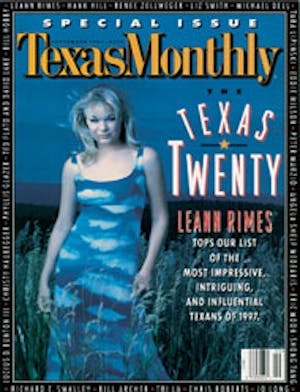IT IS POSSIBLE THAT A CHILD of the new Texas would see little more than pretty buildings in the work of San Antonio architects Ted Flato and David Lake. The thick stone walls, the generous breezeways, the shimmering metal roofs, the easy camaraderie with the landall are indigenous references that have been obscured in a Texas that has moved, in just a generation, from a rural state to an urban one. Those who have lived through the changes in the past quarter century cannot help but regard the partners’ creations with affection and gratitude.
A look at Lake/Flato Architects’ important work for just this year shows their expertise at bridging the old Texas and the new: the restored state cemetery in Austin, with its simple entry walls so contemporary yet so reminiscent of the Alamo barracks and the Spanish Governor’s Palace; the high-tech H.E.B. Science Treehouse at San Antonio’s Witte Museum, which cheerfully evokes the sinuous cast-concrete WPA bridges and picnic tables of nearby Brackenridge Park; a Laredo mental health facility, a series of shady pavilions so unassuming and welcoming that they could persuade a suspicious population to finally seek help.
The use of natural materials, the nod to Texas’ long craft traditions, and the flawless understanding of where a building should sit in the landscape combine to satisfy modern needs and modern aesthetics with age-old solutions. “We’re trying to preserve what makes Texas distinct,” says Lake. “We’re trying to move architecture forward, but to also have a sense of the permanence of the past.”
The partners, both of whom are in their forties, were born to the job. Flato (who is married to former Texas Monthly senior managing editor Katy Chadwick) grew up in Corpus Christi, jawing with his developer father around the dinner table about the best ways to improve the city. Lake was raised in Austin, where, thanks to a father who was Secretary of State under Governor Price Daniel, he got to serve as a page in the Capitol after school. “I went from eight-foot ceilings in my elementary school to this wild extravagance of space,” he says. Both Lake and Flato are rabid and unrepentant outdoorsmen, finding the beauty in unlikely camping spots like Mineral Wells. “You can do a building with enough shade, and suddenly this kind of basic open landscape you’re sitting in becomes very comfortable,” insists Flato of lessons he learned as a young man making shelters from the summer sun.
Though Flato attended Stanford and Lake the University of Texas at Austin in the seventies, their real architectural education took place during their apprenticeship in the early eighties at Ford, Powell, and Carson under San Antonio master O’Neil Ford, who understood that to succeed, a building had to be in tune with its surroundings and its culture. Ford, for instance, urged respect for local craftsmen, from German stonecutters to Mexican American dome builders. (“Stop trying to draw it your way,” Lake remembers Ford telling him. “Bring the guy in and let him show you how he does it.”) Lake and Flato started their firm in 1983 designing ranch houses and, as their style caught on, quickly moved to bigger and bigger projects without compromising their vision. The spare stone compound the pair built for San Antonio philanthropist Linda Pace is a far cry from the showy, postmodern, second-wife mansions that were in such demand just a few short years ago.
Lake and Flato’s architecture seems, in fact, a natural outgrowth of a more confident Texas, one that no longer needs outsiders to tell us who we are. At the same time, the secret to their success is something every Texan is born knowing: The landscape is harsh, the weather is harsher, the best way to survive is to accommodate, not to fight. “We want people to experience their connection to the environment, to want to be a part of the land, the topography, the weather,” says Lake. Adds Flato: “It’s not backing away from it. It’s celebrating it.”
- More About:
- Style & Design
- Architecture
- San Antonio








